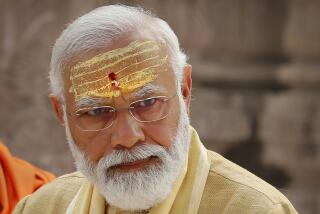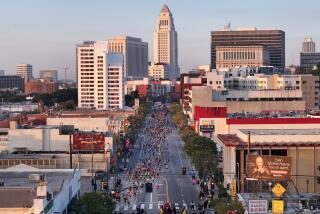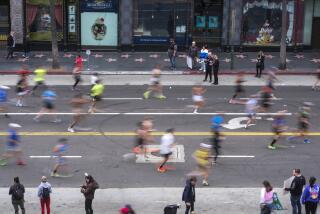In India, a marathoner finishes with a new outlook on Mumbai
Popular Bollywood beats blared from my iPod, drowning out the pounding of my heart. As I walked to the start line of the marathon, I was already drenched with sweat.
I realized this was the farthest I’d walked in Mumbai, a city of 13 million without hailing a taxi.
Yet here I was, about to run 26.2 miles through a city I’d visited numerous times but had never really seen.
Little did I know my last-minute decision to come to India to run the Standard Chartered Mumbai Marathon for charity was about to change my outlook on the city and its people and, along the way, teach me an invaluable lesson about travel.
I’m a traveler. My adventures have taken me to countries as diverse as war-torn Belfast, Northern Ireland, and the lavish United Arab Emirates.
Some experiences were more a culture shock than others, but I welcomed each as a case study about the world and its people. When I opened a suitcase, I opened my mind.
Except when it came to Mumbai. As an American-born child of Indian descent, I was always critical of Mumbai, where societal differences seemed rooted in poverty, inequality and culture. To me, the solutions were obvious and easy.
But nothing is easy in India, even something that should be as simple as getting around. I had always watched in wonder at what I called the “every-man-for-himself” method of navigation.
City dwellers move like worker bees, slipping easily and purposefully through extremely tight spaces. The frenetic pace and organized chaos are not for the faint of heart.
Maybe this was why my family and I traveled mostly by taxi or car. Perhaps that’s why I was so sensitive to the stark contrasts one finds — small children lying just feet from a five-star restaurant as patrons step over them to hail their drivers. Or giant skyscrapers that overlook unspeakable slumlike conditions.
When the shot from the starter’s pistol rang out, I was unsettled. I knew I could complete 26 miles, but I wasn’t so sure I could outrun my internal bias.
The marathon’s loop began and ended at the Chhatrapati Shivaji Terminus railway station (CST) in Churchgate, a part of town that’s constantly mobbed by tourists, college students and business executives.
Its high-rises, trendy restaurants and five-star hotels face the Arabian Sea on Marine Drive, a crescent-shaped road lined with palm trees. At night, its streetlights resemble a string of pearls also known as the Queen’s Necklace.
The “royal” lights were still on as we set out. To help keep a steady pace, I joined a group of about 40 runners, most jolly, middle-aged men. They were, as it turned out, an extremely energetic (for 5 a.m.) and supportive bunch. We ran and talked, taking turns getting to know one another.
Introductions continued as we made our way past the luxurious and beautifully restored Oberoi Hotel, one of the sites targeted in the Mumbai terrorist attacks in 2008.
We passed the street where my mother grew up and where my grandparents still live. We ran by the majestic InterContinental, formerly the Hotel Natraj, where my parents were married in 1979. I smiled thinking of them as newlyweds, anxious and excited about their future and anticipating their move to America soon thereafter.
About six miles in, I could smell the salt from the ocean and got the occasional whiff of bhelpuri, a potato, puffed rice and vegetable dish that is doused in chutney.
We had reached Chowpatty Beach, one of India’s most famous public waterfronts, where various Hindu ceremonies are performed throughout the year. It’s also known for its cheap street food and the way vendors and street performers — dancers, snake charmers, and fortunetellers — hustle tourists for business.
From afar, I could see a group of fishermen asleep on the sand, their boats anchored close by, tucked between the high-rises and the muddy waters of the Arabian Sea.
It was exactly that kind of contrast that always took me aback. Such marginalization struck me as sad and hopeless.
But something was different this time. Seeing it on foot — at eye level — revealed a subtlety I’d been missing. For the first time, instead of a forgotten wasteland, I saw mothers, children and a community.
I saw life.
Now we veered onto a three-mile stretch of the Rajiv Gandhi Sea Link, a towering cabledbridge that connects Worli, the financial district in South Mumbai, to Bandra, the city’s western suburbs.
The Indian sun rose above me, and the bridge’s pre-stressed concrete viaducts started to blur in my peripheral vision. Fatigue had begun to creep in. Now around the halfway mark, I realized I’d lost my group. We’d dispersed and were running at our own individual, more comfortable, paces.
To my surprise, the longer I ran and the more I saw, the more relaxed I became. With each mile marker, I felt as though I was letting go of what I wanted India to be and seeing it for was it was.
As I approached Mahim, an impoverished neighborhood known for its makeshift roadside food stalls, I heard children cheer and saw them waving as they lined the streets.
Some acted as unofficial volunteers, darting up and down the streets picking up empty water bottles and handing out juice boxes.
“Thank you, Didi!” they yelled, using a term which means older sister. “Go Didi, go!”
Their tiny hands reached out in hopes the other runners and I would high-five them. When someone did, they giggled and ran a few yards so our hands would meet again.
I stopped to photograph a barefoot little girl and instead of posing, she offered to tie my shoelaces. These small, humble gestures energized me for the last five miles.
I sprinted the last hundred feet past the Chhatrapati Shivaji Terminus train station, where just 5 1/2 hours earlier my adventure had begun.
Tired and dehydrated, I crossed the finish line looking for my family. There wasn’t much time to reflect, though. Runners were still on the road as city officials and event organizers started to tear down barriers and let traffic and pedestrians through.
It was a bit rushed and anticlimactic. In true Indian fashion, Mumbai’s hustle stopped for no one, and life continued on.
No matter. The run was one of the most extraordinary experiences of my life, proving to me yet again that traveling on foot has a profound impact on one’s experience.
After all these years, perhaps the more convenient modes of transportation — cars, taxi, train — had actually done me a disservice, limiting the full scope of my experience.
Running Mumbai made me realize that it wasn’t what I saw that made me anxious or comfortable but what I didn’t see. I learned that in this teeming, frustrating and fascinating city, hardship and suffering dwelled alongside hope and resilience.
At last, I saw it.
Trishna Patel, a former collegiate athlete and Los Angeles native, runs the L.A. Marathon every year. The 2014 Mumbai marathon race was her first international race and 10th 26.2-mile run.
Follow us on Twitter at @latimestravel
More to Read
Sign up for The Wild
We’ll help you find the best places to hike, bike and run, as well as the perfect silent spots for meditation and yoga.
You may occasionally receive promotional content from the Los Angeles Times.






